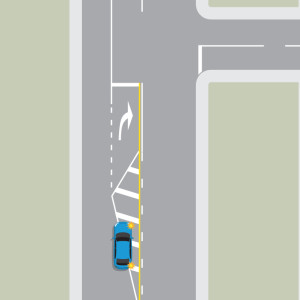Signals tell other road users you’re changing your direction or position on the road. Knowing when and how to give signals is an important part of being a safe driver.
Drivers usually signal using their indicators. However, you may sometimes need to use hand signals if your indicators can’t be seen.
You must signal for at least 3 seconds before you:

Signalling when turning right
Indicators tell other road users what you’re going to do. Front indicators are amber or white. Rear indicators are amber or red.
Important!Don’t assume that other drivers have seen your signals. |
Use your left indicator when you're:

Use your right indicator when you're:

Right-turn hand signal

Right indicator
Important!Don’t just rely on the other driver’s signal. Is the vehicle slowing down? Is the vehicle in the right place on the road in relation to the signal? |
Your brake lights, the red lights at the back of your vehicle, let people behind you know that you’re slowing down or stopping. Brake lights come on automatically when you use the brake pedal (footbrake). Keep your foot on the brake pedal to keep the brake light on to warn other drivers.

Stop or slowing hand signal

Brake lights
Tip: tapping the brake pedal will flash the brake lights to warn other drivers.
When you turn on your hazard lights, both indicator lights flash at the same time as a warning to other road users. You should turn on your hazard lights when your vehicle becomes a temporary hazard to other road users, such as when: